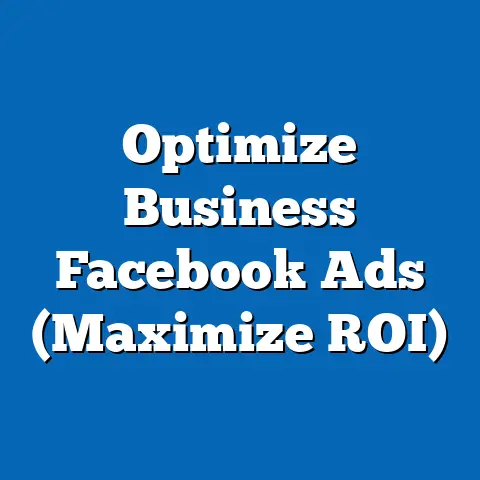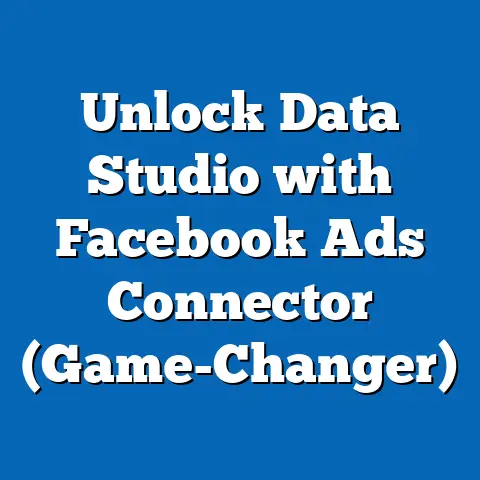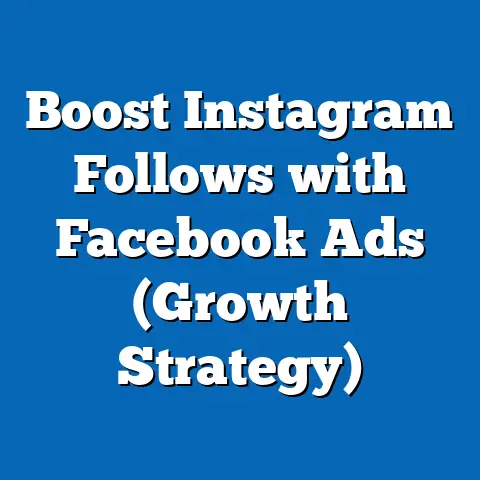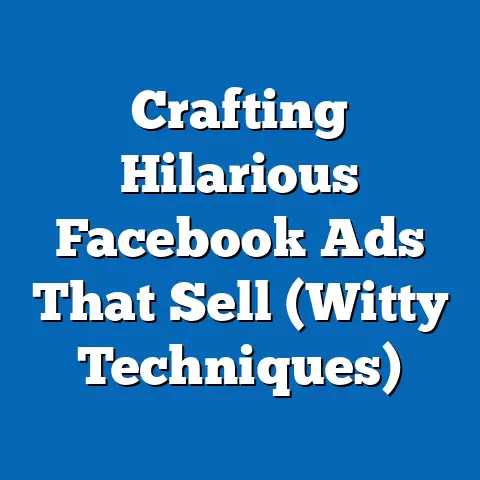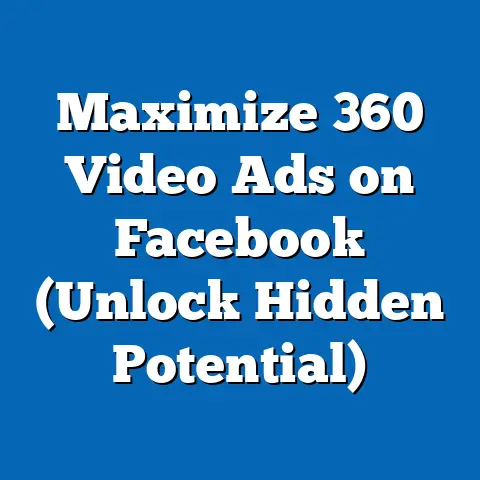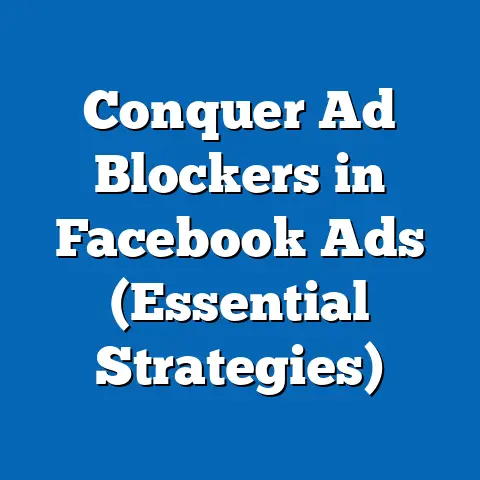Boost CTR with Proven Facebook Ads Strategies (Expert Insights)
What if you could double your click-through rate (CTR) on Facebook Ads and drive unprecedented traffic to your website? It’s a tantalizing thought, isn’t it? The truth is, achieving a significantly higher CTR on Facebook isn’t just a pipe dream. It’s a tangible goal that many businesses reach by implementing proven strategies and understanding the nuances of the platform. In this article, I’ll delve into the world of Facebook advertising, sharing expert insights and actionable techniques that can dramatically enhance your CTR, leading to better campaign performance, increased website traffic, and a stronger return on investment (ROI). I’ll draw upon my own experiences, industry benchmarks, and successful case studies to equip you with the knowledge and tools you need to transform your Facebook ad campaigns.
Understanding Click-Through Rate (CTR)
Before diving into the strategies, let’s establish a solid understanding of what CTR actually is and why it’s so important.
What is CTR?
Click-through rate (CTR) is a metric that measures the percentage of people who view your ad (impressions) and then click on it. It essentially tells you how relevant and engaging your ad is to your target audience. The formula for calculating CTR is simple:
CTR = (Total Clicks / Total Impressions) x 100
For example, if your ad receives 1,000 impressions and 20 clicks, your CTR would be 2%.
Why is CTR Important?
CTR is a crucial indicator of your ad’s effectiveness for several reasons:
- Relevance Score: Facebook uses CTR as a key factor in determining your ad’s relevance score. A higher relevance score can lead to lower advertising costs and better ad placement. I’ve personally seen ads with high relevance scores get significantly more impressions for the same budget.
- Quality Score: Similar to Google Ads, Facebook uses a “quality score” which factors in CTR. A higher quality score indicates that your ad is providing a positive user experience.
- Cost-Effectiveness: A higher CTR means you’re getting more clicks for your money. This translates to a lower cost-per-click (CPC) and a higher ROI. I remember working with a client who was struggling with high CPCs. By optimizing their ad copy and targeting, we were able to double their CTR and reduce their CPC by 40%.
- Website Traffic: Ultimately, the goal of many Facebook ad campaigns is to drive traffic to your website. A higher CTR directly translates to more visitors, increasing your chances of conversions and sales.
- Brand Awareness: Even if users don’t immediately convert, a compelling ad with a high CTR can increase brand awareness and recognition.
What is a Good CTR?
Determining what constitutes a “good” CTR can be tricky, as it varies depending on several factors, including:
- Industry: Some industries naturally have higher CTRs than others. For example, ads promoting entertainment or lifestyle products might have higher CTRs than ads for financial services.
- Target Audience: The more targeted your audience, the higher your CTR is likely to be.
- Ad Placement: Different ad placements (e.g., Facebook feed, Instagram Stories, Audience Network) can have varying CTRs.
- Ad Objective: Ads optimized for different objectives (e.g., brand awareness, lead generation, conversions) can have different CTR expectations.
Industry Benchmarks:
While specific numbers can fluctuate, here are some general industry benchmarks for Facebook ad CTRs:
- Average CTR across all industries: Around 0.9% (Source: WordStream)
- High-performing industries (e.g., apparel, retail): Can reach 1.5% or higher.
- Lower-performing industries (e.g., finance, insurance): May be closer to 0.5%.
It’s important to remember that these are just averages. Your goal should be to continuously improve your CTR and outperform your previous results. I always advise clients to focus on relative improvement rather than blindly chasing industry benchmarks.
Takeaway: Understanding CTR is fundamental to successful Facebook advertising. It’s a vital indicator of your ad’s relevance, cost-effectiveness, and overall performance. Aim to continuously improve your CTR by implementing the strategies I’ll outline in the following sections.
Crafting Compelling Ad Copy
Your ad copy is your opportunity to grab attention, pique interest, and persuade users to click. It’s the voice of your brand and the key to connecting with your target audience.
Expert Insights on Persuasive Ad Copy
- Know Your Audience: Before writing a single word, thoroughly understand your target audience. What are their pain points? What are their aspirations? What language do they use? The more you know, the more effectively you can tailor your message. I once worked on a campaign targeting new parents. By using language that resonated with their anxieties and joys, we saw a significant increase in CTR.
- Highlight Benefits, Not Just Features: Focus on the benefits that your product or service provides, rather than just listing its features. Tell users how it will improve their lives, solve their problems, or fulfill their desires. For example, instead of saying “Our software has advanced analytics,” say “Gain actionable insights and make data-driven decisions with our advanced analytics.”
- Use Strong Verbs and Action Words: Inject energy and urgency into your ad copy with strong verbs and action words. Words like “discover,” “transform,” “unlock,” and “achieve” can create a sense of excitement and motivate users to click.
- Keep it Concise and Clear: Facebook users are scrolling quickly. Get to the point and avoid jargon or overly complex language. Use short sentences and easy-to-understand words.
- Ask Questions: Engaging questions can pique curiosity and encourage users to learn more. For example, “Tired of feeling tired? Discover our new energy-boosting supplement.”
- Create a Sense of Urgency or Scarcity: Limited-time offers, exclusive deals, and phrases like “while supplies last” can create a sense of urgency and encourage users to click before they miss out.
- Use Numbers and Statistics: Concrete data can add credibility and make your claims more believable. For example, “90% of our customers report increased productivity after using our software.”
The Power of Emotional Triggers and Storytelling
Connecting with your audience on an emotional level can significantly boost your CTR. Consider using emotional triggers such as:
- Fear of Missing Out (FOMO): Tap into the desire to stay in the loop and avoid missing out on something important.
- Nostalgia: Evoke feelings of nostalgia by referencing past experiences or trends.
- Humor: Use humor to grab attention and make your ad more memorable.
- Empathy: Show that you understand your audience’s struggles and frustrations.
- Inspiration: Inspire users to achieve their goals and live their best lives.
Storytelling is another powerful tool for engaging your audience and making your ad more relatable. Share a personal story, a customer testimonial, or a case study that demonstrates the value of your product or service. I remember running a campaign for a weight loss program that featured before-and-after photos and personal stories from real clients. The ads with the storytelling elements performed significantly better than the ones that simply listed the program’s features.
Examples of High-Performing Ad Copy
Let’s analyze a few examples of high-performing ad copy and dissect what makes them effective:
Example 1: Shopify (E-commerce Platform)
- Headline: Start Your Free Trial Today!
- Body: Sell anything, anywhere. Get everything you need to start, run, and grow your business. 14-day free trial. No credit card required.
- Analysis: This ad copy is concise, clear, and benefit-oriented. It highlights the key benefits of using Shopify (selling anything, anywhere) and offers a risk-free trial. The “no credit card required” adds an extra layer of reassurance.
Example 2: Grammarly (Writing Assistant)
- Headline: Great Writing, Simplified.
- Body: Grammarly helps you eliminate errors and find the perfect words to express yourself. Be sure to say exactly what you mean, with confidence.
- Analysis: This ad copy focuses on the emotional benefits of using Grammarly (confidence, clarity). It also highlights the key features (error elimination, perfect word choice) in a concise and compelling way.
Example 3: Monday.com (Project Management Software)
- Headline: Get Your Team on the Same Page
- Body: Manage projects, automate workflows, and collaborate seamlessly with monday.com. Start your free trial today!
- Analysis: This ad copy addresses a common pain point (team disorganization) and offers a solution (monday.com). It also highlights the key benefits (project management, workflow automation, collaboration) and includes a clear call to action (start your free trial).
Takeaway: Crafting compelling ad copy is a crucial skill for any Facebook advertiser. By understanding your audience, highlighting benefits, using strong verbs, and incorporating emotional triggers, you can create ads that grab attention, pique interest, and drive clicks. Remember to analyze successful ad copy examples and adapt their techniques to your own campaigns.
Eye-Catching Visuals and Design
In the fast-paced world of social media, visuals are your first opportunity to grab attention. A compelling image or video can stop users in their tracks and entice them to learn more.
The Role of Visuals in Capturing Attention
Visuals are processed much faster than text, making them incredibly effective at capturing attention. A well-chosen image or video can instantly convey your message, evoke emotions, and create a lasting impression. I’ve found that ads with high-quality visuals consistently outperform those with generic or low-resolution images.
Best Practices for Choosing Images, Videos, and Graphics
- Relevance: Your visuals should be directly relevant to your ad copy and your target audience.
- High Quality: Use high-resolution images and videos that are clear, crisp, and visually appealing. Avoid blurry or pixelated visuals.
- Authenticity: Use authentic images and videos that showcase your brand and your products or services in a genuine way. Avoid using stock photos that look generic or staged. I had a client who insisted on using stock photos for their ads, and their CTR was consistently low. When we switched to using real photos of their products and customers, their CTR nearly doubled.
- Color Psychology: Consider the psychological impact of colors when choosing your visuals. Different colors can evoke different emotions and associations. For example, blue often conveys trust and reliability, while red can convey excitement and urgency.
- Branding: Incorporate your brand colors, logo, and other visual elements into your ads to create a consistent brand identity.
- Mobile Optimization: Ensure that your visuals are optimized for mobile devices, as the majority of Facebook users access the platform on their smartphones.
Examples of Successful Ad Creatives
Let’s examine some examples of successful ad creatives and dissect their design elements:
Example 1: Nike (Apparel)
- Visual: Dynamic action shot of an athlete wearing Nike apparel.
- Design Elements: High-contrast colors, strong composition, clear focus on the product.
- Analysis: This ad creative is visually striking and conveys a sense of energy and athleticism. It effectively showcases the Nike apparel and appeals to the target audience of athletes and fitness enthusiasts.
Example 2: Airbnb (Travel)
- Visual: Stunning photo of a unique Airbnb property in a desirable location.
- Design Elements: Warm lighting, inviting atmosphere, clear depiction of the experience.
- Analysis: This ad creative evokes a sense of wanderlust and inspires users to book their next vacation. It effectively showcases the unique properties available on Airbnb and appeals to the target audience of travelers.
Example 3: Spotify (Music Streaming)
- Visual: Animated video showcasing the Spotify app and its features.
- Design Elements: Bright colors, engaging animation, clear demonstration of the product’s value.
- Analysis: This ad creative is visually appealing and effectively demonstrates the benefits of using Spotify. It appeals to the target audience of music lovers and highlights the app’s user-friendly interface.
Takeaway: Eye-catching visuals are essential for capturing attention and improving CTR on Facebook. By choosing relevant, high-quality images and videos that are optimized for mobile devices and aligned with your brand identity, you can create ads that stand out from the crowd and entice users to click.
Targeting the Right Audience
Even the most compelling ad copy and visually stunning creatives will fail if they’re not seen by the right people. Targeting the right audience is crucial for maximizing your CTR and achieving your advertising goals.
The Importance of Audience Segmentation
Audience segmentation involves dividing your target market into smaller groups based on shared characteristics, such as demographics, interests, behaviors, and online activity. This allows you to create more targeted and relevant ads that resonate with each segment. I’ve consistently seen that ads targeted to specific audience segments outperform those targeted to broad audiences.
Facebook’s Targeting Options
Facebook offers a wide range of targeting options, including:
- Demographics: Target users based on age, gender, location, education, relationship status, and job title.
- Interests: Target users based on their interests, hobbies, and the pages they like on Facebook.
- Behaviors: Target users based on their online behavior, such as purchase history, device usage, and travel habits.
- Custom Audiences: Create custom audiences by uploading your own customer data, such as email lists or phone numbers.
- Lookalike Audiences: Create lookalike audiences by identifying users who share similar characteristics to your existing customers.
- Retargeting: Retarget users who have previously interacted with your website or Facebook page.
Strategies for Precise Targeting
- Start with Broad Targeting and Refine: Begin by targeting a broad audience based on demographics and interests, and then use Facebook’s analytics to identify the segments that are performing best. Refine your targeting based on these insights.
- Use Layered Targeting: Combine multiple targeting options to create highly specific audiences. For example, you could target users who are interested in both “yoga” and “meditation,” and who also have a “fitness” behavior.
- Leverage Custom Audiences: Upload your customer data to create custom audiences and target your existing customers with special offers or promotions.
- Create Lookalike Audiences: Use your custom audiences to create lookalike audiences and expand your reach to new potential customers who share similar characteristics to your existing customers.
- Implement Retargeting: Retarget users who have visited your website or Facebook page but haven’t yet converted. Show them ads that are relevant to the products or services they were interested in. I always recommend implementing retargeting campaigns, as they often have the highest ROI.
Expert Insights on Targeting
- Test Different Audiences: Don’t be afraid to experiment with different targeting options and audience segments. A/B test different audiences to see which ones perform best.
- Monitor Your Results: Continuously monitor your campaign results and adjust your targeting based on the data.
- Stay Up-to-Date: Facebook’s targeting options are constantly evolving. Stay up-to-date on the latest features and best practices.
Takeaway: Targeting the right audience is essential for maximizing your CTR and achieving your advertising goals. By using Facebook’s diverse targeting options, segmenting your audience, and continuously monitoring your results, you can create highly targeted campaigns that resonate with your ideal customers.
A/B Testing for Optimization
A/B testing, also known as split testing, is a powerful technique for optimizing your Facebook ad campaigns. It involves creating two or more versions of an ad (A and B) and showing them to different segments of your audience to see which version performs better.
The Significance of A/B Testing
A/B testing allows you to make data-driven decisions about your ad copy, visuals, targeting, and other elements. By systematically testing different variations, you can identify the factors that are most effective at driving clicks and conversions. I consider A/B testing to be an indispensable part of any successful Facebook advertising strategy.
A Step-by-Step Guide to Effective A/B Testing
- Define Your Hypothesis: Before you start testing, define a clear hypothesis about what you want to test and what you expect to happen. For example, “I hypothesize that using a brighter image will increase my CTR.”
- Choose One Variable to Test: Focus on testing one variable at a time to isolate the impact of that variable on your results. For example, test different headlines, images, or call-to-actions.
- Create Two Versions of Your Ad: Create two versions of your ad that are identical except for the variable you are testing.
- Set Up Your A/B Test in Facebook Ads Manager: Use Facebook Ads Manager to set up your A/B test. Choose the “A/B Test” objective and follow the instructions to create your two ad sets.
- Run Your Test for a Sufficient Period: Allow your A/B test to run for a sufficient period to gather enough data to draw statistically significant conclusions. I recommend running your test for at least a week.
- Analyze Your Results: After your test has run, analyze the results to see which version performed better. Look at metrics such as CTR, CPC, and conversion rate.
- Implement the Winning Version: Implement the winning version of your ad and continue to monitor its performance.
- Repeat the Process: A/B testing is an ongoing process. Continuously test different variables to optimize your campaigns and improve your results.
Case Studies of Successful A/B Tests
- Image Testing: A company that sells online courses A/B tested different images in their Facebook ads. They found that using an image of a student smiling and engaged in learning increased their CTR by 25%.
- Headline Testing: An e-commerce store A/B tested different headlines in their Facebook ads. They found that using a headline that highlighted a limited-time discount increased their CTR by 18%.
- Call-to-Action Testing: A software company A/B tested different call-to-actions in their Facebook ads. They found that using a call-to-action that encouraged users to “Start Your Free Trial” increased their conversion rate by 12%.
Takeaway: A/B testing is a powerful technique for optimizing your Facebook ad campaigns. By systematically testing different variables and analyzing your results, you can make data-driven decisions that lead to significant improvements in CTR and ROI.
Utilizing Call-to-Actions (CTAs)
Your call-to-action (CTA) is the final nudge that encourages users to take the desired action. It’s the button or text that tells users what you want them to do next.
The Critical Role of CTAs
A well-crafted CTA can significantly impact your CTR and conversion rate. It provides clear direction and motivates users to click, learn more, or make a purchase. I’ve seen CTAs make the difference between a mediocre ad and a high-performing one.
Tips for Crafting Compelling CTAs
- Use Action-Oriented Language: Use strong verbs that encourage users to take action. Examples include “Shop Now,” “Learn More,” “Sign Up,” “Download,” and “Get Started.”
- Make it Clear and Concise: Your CTA should be easy to understand and immediately recognizable.
- Create a Sense of Urgency: Use language that creates a sense of urgency or scarcity, such as “Limited Time Offer” or “Shop Now Before It’s Gone.”
- Match the CTA to Your Offer: Ensure that your CTA is relevant to your ad copy and your offer. For example, if you’re offering a free ebook, your CTA should be “Download Now.”
- Use Contrasting Colors: Make your CTA button stand out by using a contrasting color that draws the eye.
- Test Different CTAs: A/B test different CTAs to see which ones perform best.
Examples of Effective CTAs
- Shop Now: Ideal for e-commerce ads that promote products or services.
- Learn More: Suitable for ads that provide information or education.
- Sign Up: Effective for ads that encourage users to create an account or subscribe to a newsletter.
- Download: Appropriate for ads that offer free downloads, such as ebooks or white papers.
- Get Started: Useful for ads that promote software or other tools that require users to create an account and get started.
Analyzing the Impact of CTAs on CTR
- “Shop Now” vs. “View Products”: An e-commerce store A/B tested these two CTAs and found that “Shop Now” increased their CTR by 15%.
- “Learn More” vs. “Discover More”: A software company A/B tested these two CTAs and found that “Discover More” increased their CTR by 10%.
- “Sign Up” vs. “Get Started”: A subscription service A/B tested these two CTAs and found that “Get Started” increased their conversion rate by 8%.
Takeaway: Your call-to-action is a critical element of your Facebook ad. By crafting compelling CTAs that are action-oriented, clear, and relevant to your offer, you can significantly improve your CTR and drive more conversions.
Leveraging Facebook’s Ad Features
Facebook offers a variety of ad features that can enhance engagement and drive clicks.
Exploring Advanced Features
- Carousel Ads: Carousel ads allow you to showcase multiple images or videos in a single ad. This format is ideal for highlighting different products, features, or benefits.
- Slideshow Ads: Slideshow ads allow you to create engaging video-like experiences using static images. This format is a cost-effective way to create visually appealing ads.
- Dynamic Ads: Dynamic ads allow you to automatically show users ads for products they have previously viewed on your website. This format is highly effective for retargeting and driving conversions.
- Lead Ads: Lead ads allow you to collect leads directly within Facebook. This format is ideal for generating leads for your business.
- Collection Ads: Collection ads allow you to showcase your products in a visually appealing and interactive way. This format is ideal for e-commerce businesses that want to drive sales.
Expert Insights on Using Facebook’s Ad Features
- Carousel Ads for Product Showcases: Use carousel ads to showcase multiple products and highlight their key features.
- Slideshow Ads for Storytelling: Use slideshow ads to tell a story about your brand or your products.
- Dynamic Ads for Retargeting: Use dynamic ads to retarget users who have previously viewed products on your website.
- Lead Ads for Lead Generation: Use lead ads to collect leads directly within Facebook.
- Collection Ads for Driving Sales: Use collection ads to showcase your products and drive sales.
When and How to Use these Features Effectively
- Carousel Ads: Use carousel ads when you have multiple products or features to showcase.
- Slideshow Ads: Use slideshow ads when you want to create an engaging video-like experience without the cost of producing a video.
- Dynamic Ads: Use dynamic ads when you want to retarget users who have previously viewed products on your website.
- Lead Ads: Use lead ads when you want to generate leads for your business.
- Collection Ads: Use collection ads when you want to showcase your products and drive sales.
Takeaway: Facebook offers a variety of ad features that can enhance engagement and drive clicks. By understanding these features and using them effectively, you can create more compelling and successful Facebook ad campaigns.
Conclusion
Boosting your click-through rate on Facebook ads isn’t about luck; it’s about strategy, testing, and continuous optimization. By understanding the importance of CTR, crafting compelling ad copy, using eye-catching visuals, targeting the right audience, A/B testing your ads, utilizing effective CTAs, and leveraging Facebook’s ad features, you can significantly improve your campaign performance and achieve your advertising goals.
Remember, the landscape of Facebook advertising is constantly evolving. It’s crucial to stay up-to-date on the latest features, best practices, and industry trends. Continuous learning and adaptation are essential for long-term success.
I encourage you to implement the expert insights I’ve shared in this article in your own Facebook ad campaigns. Start by focusing on one or two key areas, such as ad copy or targeting, and gradually expand your efforts as you gain experience. Track your results, analyze your data, and continuously optimize your campaigns based on your findings. With dedication and a data-driven approach, you can unlock the full potential of Facebook advertising and achieve unprecedented success. Now go out there and boost your CTR!

